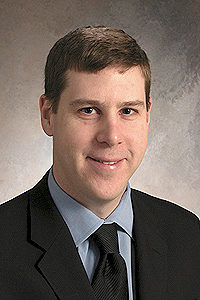Leading genomicist will establish institute for genomics, systems biology
By John EastonMedical Center Public Affairs
 Kevin White | |
Kevin White, a pioneer in combining experimental and computational techniques to understand the networks of factors that control gene expression during development and evolution, has been appointed Professor in Human Genetics and Ecology & Evolution, and he will direct the new Institute for Genomic & Systems Biology. White’s appointments, which are effective Saturday, July 1, include an appointment at Argonne National Laboratory.
White, 35, comes to Chicago from the Yale University School of Medicine, where he is an associate professor in genetics and ecology and evolutionary biology, as well as director of applied genomics in the Yale Center for RNAi and Therapeutic Chemical Genetics.
“Kevin is one of the first true genomicists,” said Chung-I Wu, Chairman of Ecology & Evolution. “He was among the first to design genome-scale experiments and apply them to the big questions in genetics and evolution.”
“Getting Kevin was a real coup,” said Conrad Gilliam, Chairman of Human Genetics. “At first, we thought it was nearly impossible.” But seven departments at the University, plus Argonne and the Chicago Biomedical Consortium, teamed up to pool resources. In the end, Gilliam said, “I think our enthusiasm, plus the range of collaborative potential we assembled, made the difference.”
“It all came down to institutional structure and vision,” White said. “Chicago has lots of assets, including arguably the best molecular evolution and statistical genetics in the world, but Yale also has real strengths. Both places were eager to invest in systems biology.
“But Chicago has an institution-wide commitment to interdisciplinary research that’s going to be key to the development of our genomes-to-medicine concept. It also offers a close connection to the proteomics, computation and engineering talents at Argonne, where the institute’s activities will be focused on biological solutions to problems such as alternative energy production.”
White studies how networks of genes and proteins control development and disease and how they produce differences between individuals or between species. Using the knowledge gained from the genome-scale approaches he employs, his efforts at the University will focus on biomarker and therapeutic discovery for complex diseases such as cancer, and at Argonne on engineering organisms that are critical for biofuel production.
White has a history of connecting new technology to biology. At Stanford University in the 1990s, White was the first to recognize that emerging microarray technology could be applied to the study of fundamental problems in developmental genetics and evolution. At Yale University, he seized upon RNA interference to perform systematic analysis of gene function for entire genomes.
Most of White’s initial research focused on fruit flies. His more recent work, however, has applied approaches developed in flies to the study of human evolution and disease.
In one recent high-profile paper, White and Yoav Gilad, Assistant Professor in Human Genetics, used the first multi-species gene arrays to solve a 30-year-old mystery. Humans and chimpanzees are obviously quite different, but a 1975 landmark study found that their genes are nearly identical. In the Wednesday, March 8 issue of Nature, White’s team revealed that the differences were not caused by variation in the genes but by changes in gene regulation.
Genes that do not differ in expression between humans and other species, they also showed, are likely to be involved in diseases such as cancer when misregulated. White’s team is now screening the entire human genome to find genes that are potential new biomarkers for cancer progression.
Another project focuses on fruit flies that have been under selective pressure for hundreds of generations to survive in an environment with limited oxygen. Normal air contains about 21 percent oxygen, but White has bred colonies that can live with less than 4 percent oxygen, a level one-third “thinner” than the air atop Mount Everest.
“In this case,” he explained, “we are interested in the evolution of a clinically important trait. Stroke, heart attack and many trauma patients are subjected to the effects of hypoxia. We intend to determine how these flies—and ultimately human heart or brain tissue— can endure reduced oxygen levels.” His team already has identified several genes that enhance survival in such conditions.
White graduated magna cum laude from Yale University with a joint B.S.-M.S. degree in biology in 1993. He completed his Ph.D. in developmental biology at Stanford University in 1998, followed by a postdoctoral fellowship in biochemistry and genomics at the Stanford Genome Technology Center.
In 2000, he joined the faculty at Yale University as an assistant professor of genetics. He was named an NIH Genome Scholar in 2000, a W.M. Keck Distinguished Young Investigator in Medical Sciences in 2003, and an Arnold and Mabel Beckman Young Investigator in 2004.
In 2004, he was elected chairman of the Gordon Conference on Genomics and in 2005, vice-chairman of the Gordon Conference on Hormone Action in Development and Cancer.
To create the Institute for Genomic & Systems Biology, White will partner with several biological science departments and Argonne. The institute will eventually house nine core faculty members in genomics and computational biology at Chicago as well as several scientists at Argonne. It will move to a permanent home in the Center for Biomedical Discovery when it opens in 2008.
“We have ambitious goals. We hope this institute will fulfill some of the promises of the Human Genome Project, genomics and systems biology in general, including better diagnostics and therapeutics as well as solutions for environmental and energy problems.”
The resources at the University and Argonne “provide an environment where genomics and systems biology can have a tremendous impact,” he said. “This the right place at the right time.”
![[Chronicle]](/images/sidebar_header_oct06.gif)